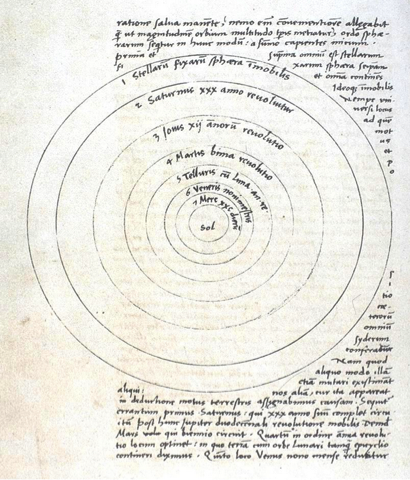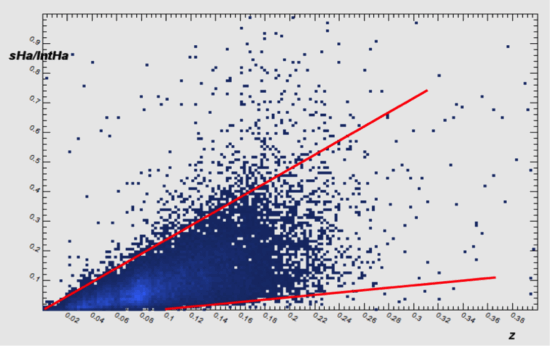Is the Cosmos Static or Is It Expanding?
On the hundred-year-old dispute over the interpretation of the redshift of galaxy spectra
by Mathias Hüfner
ABSTRACT: For the Standard Model of Cosmology, which sees the act of creation in a Big Bang 13.5 billion years ago, the interpretation of the redshift of galaxy spectra as a measure of speed and distance is essential. Doubting this brings the entire model crashing down. However, the very idea of the model has come under increasing threat since the systematic exploration of the cosmos by ever more powerful telescopes and the conquest of Earth’s orbit by observing space probes. But the academic elite, in their unrealistic delusion, refuses to abandon their model at any cost. Their inventions to support their model are becoming increasingly implausible and contradictory. In the case of redshift, the systematic recording of galaxy spectra by the SDSS project has provided sufficient material to refute the theory of the expansion of a closed cosmos.

At the beginning of the 20th century, not much was known about the universe since the Middle Ages. There were seven nested spheres. Only the Sun and Earth had swapped places when Copernicus published his revolutionary work De revolutionibus orbium coelestium, but the idea of the seven spheres on which the planets orbited had survived. Then, in 1915, the young Albert Einstein came along and reduced the spheres to one, added an independent absolute time, rejected Newton’s material gravitational force, and conjured up gravity as a curvature of space from the tensor description of a sphere. He called this botch “The Field Equations of Gravitation” and wasn’t sure whether he would be sent to a madhouse for it. A generation earlier, that would certainly have happened, because the Leipzig physicist Karl Friedrich Zöllner lost his reputation when he expressed ideas about a four-dimensional space in his “Explanation of Universal Gravitation” in 1882.1 2

On the basis of general relativity, Alexander Friedmann and Georges Lemaitre independently inflated Einstein’s closed model of the cosmos in the 1920s without ever having seen through a telescope. Friedmann solved Einstein’s equation and found a mathematical singularity, which, depending on the choice of parameters, was interpreted as an expansion or mass concentration, without even beginning to discuss the real physical conditions. Ultimately, the cosmos had to be finite and expanding, since, according to Christian belief, God existed outside of this model world.
A hundred years ago, Edwin Hubble’s discoveries in extra-galactic astronomy, made with the newly opened 2.5 m reflecting telescope on Mount Wilson, such as the relationship between redshift and light intensity of galaxies, which at the time were still considered planetary nebulae, came just in time to support the Big Bang hypothesis. It had already been recognized that the smallest shifts in the spectral lines of stellar spectra is caused by the Doppler effect. The Doppler effect of light is based solely on the fact that the light source and the observer are moving relative to each other, and the speed of light is either added to or subtracted from the speed of the light source, something that is impossible according to Einstein’s theory of relativity. After all, he invented the curvature of space for this purpose. But he stuck to a static model of the world. It was only his encounter with Hubble that changed his view. What had been recognized as correct for stellar spectra was now applied to the newly discovered nebulae.

However, Hubble became suspicious when he obtained speeds of nearly 1/7 the speed of light due to the much larger redshifts in faint galaxies, based on the Doppler effect.3 Nowadays, thanks to the LHC, we have an idea of the enormous energies required to accelerate a few protons to such speeds.
As early as 1929, Fritz Zwicky therefore proposed explaining the spectral redshift of galaxies as a phenomenon of light fatigue. At the time, however, his theory found no prominent supporters. Hubble’s relationship between redshift and light attenuation went down in astrophysics history as the Hubble constant, although it is not a constant and its value has decreased from 500 km/s Mpc in 1927 to its current value of 73-75 km/s Mpc. It is interpreted by the established scientific community as the velocity of the expansion of space. This difference between its original and current value is called the Hubble tension and is one of the greatest mysteries of modern cosmology.

Hubble’s most prominent student, Halton Arp, through careful observations found a number of cosmic objects that appeared optically connected but exhibited very different redshifts in their spectra. His falsification of the idea of spectral redshift as a measure of the expansion of the cosmos thoroughly displeased academic theorists, and he was denied further observing time at the new Palomar Observatory in the 1980s due to his controversial views on the cosmos and established doctrine. Eventually, he found a new scientific home in Germany and was listed as a visiting scientist at the Max Planck Institute in Munich. He compiled the ” Atlas of Peculiar Galaxies” and published books on the intrinsic redshift of galaxies.
Paul Marmet believed that bremsstrahlung, the forward scattering of electromagnetic pulses by electrons, is not limited to gamma and X-ray radiation, but also occurs in visible light, with a small fraction of the energy being transferred to electrons.4 In any case, no lower wavelength limit for bremsstrahlung has been found. This low energy release has simply not been detectable until now. This correlates with Arp’s observation that young quasars that have left an active galaxy exhibit a particularly large redshift in their absorption spectra. Paul Marmet suffered no less hardship for his critical stance toward established doctrines. He was labeled a heretic and banned from his place of work, the University of Ottawa, in 1999. Between 1997 and 1999, several established physicists vehemently objected to the fact that Marmet’s research called into question the fundamental principles of physics. They wrote an open letter to the physics community.5 A veritable war of faith erupted over the cause of the redshift, with the smaller party having the better arguments. The reaction of the proponents of the established doctrine was correspondingly sharp.
In order to separate the shift of the spectral line due to the Doppler effect on the one hand from the shift due to energy loss on the other, you must examine the properties of the spectral lines, because the Doppler effect affects a spectral line differently than energy loss. As the movement between the light source and the observer has no influence on the emission process of the light, no change in the spectral line itself is to be expected due to the Doppler effect. The ratio of line height to width must remain constant here, as all emitters of the entire light source have the same speed. However, when the light loses energy, the spectral line widens, which increases the ratio of width to height and shifts the line maximum to the “right”. A clear dependence of the line width on the redshift is evident. Since the conditions with regard to galaxies vary greatly, a lower and an upper limit of the line width can be expected as a function of the redshift.

In 2008, I had the opportunity to participate in a project to classify galaxies according to the Hubble scheme. The Sloan Digital Sky Survey’s Release 3 cataloging of the sky, containing approximately 300,000 galaxy spectra, had just been completed.6
Since I have been very familiar with reading spectra since my involvement in the further development of equipment for the evaluation of atomic spectra of the laser micro-spectral analysis at Zeiss, I have analyzed the active galaxies concerning the broadening of the Ha-lines at 656.2nm as a function of their redshift. The result of a corresponding database query of Release 3 is shown in Figure 5. I obtained a point array for the relative width of the Ha-line of each measured galaxy in relation to its redshift.
There, contrary to what was expected for the Doppler effect, it turns out that the point field in which most galaxies lie is actually bounded by two straight lines with a significant gradient. The only conclusion that can be drawn is that there are processes between galaxies that simultaneously cause line broadening at redshift, which is related to a decrease in the energy of light over cosmic distances. The electrons of the cosmic plasma likely play a crucial role in this. However, these mechanisms are still poorly understood.

Figure 6 illustrates the effect using a Gaussian normal distribution. The area under the curve remains constant, while the maximum shifts to longer wavelengths. The bell-shaped curve expands in width. This inevitably leads to a decrease in intensity.
It follows inevitably that the cosmos is a volume filled with matter, in contrast to the mathematically empty space you may imagine. As early as 1855, Wilhelm E. Weber and Rudolph Kohlrausch demonstrated that the speed of light is a material constant, identifying it as the inverse of the square root of the electric field constant times the magnetic field constant. The density of the radiating medium can also be estimated based on the radiation.

In Figure 5, we examined the Hα line of galaxies. It originates from the gas that glows freely in cosmic space between the stars of each galaxy. To emit a wavelength of 656.2 nm, a loop antenna must have a diameter of λ / π , as shown in Figure 7.7 Therefore, the atomic shell must have at least this diameter for the Hα– line to be emitted by the gas. We know that a gas fills the entire available volume. From the ideal gas law, we can now estimate the maximum hydrogen pressure within a galaxy. In the ideal case, this would be 2.616 × 10¹⁵ Atoms per cubic centimeter. At a packing density of 50%, which is usually assumed as the packing density for liquids, this would still result in 1.3 × 10¹⁵ atoms per cubic centimeter. Assuming a temperature of 5 K, the pressure in a galaxy would be about 90 nPa (nanopascals) under these conditions. This is an ultra-high vacuum, but given the unimaginable distances across a galaxy, there’s probably more mass between than the stars contain, and, most importantly, this medium is dense for momentum transfer.
Precisely because the gas pressure in space is very low, the electron orbit can expand so much that, if interrupted, it can emit an electromagnetic wave in the visible range, and even small disturbances lead to ionization. This is why the cosmos is an electrical medium, as Weber and Kohlrausch discovered in the mid-19th century. In 1928, Irving Langmuir coined the term “plasma” for this purpose.
All atoms that, according to Maxwell, do not experience interruptions in their electron orbits do not themselves luminous, but they transmit the received electromagnetic impulse, since gases are coherent in volume. No new particles need to be invented for this. Every transmission channel for electromagnetic radiation has an attenuation. The cosmic medium, formerly known as the ether, therefore also has an attenuation. The Hubble constant then tells us something about the attenuation of the speed of light over a megaparsec of the static cosmos in a particular viewing direction. Trying to measure cosmic velocities via light attenuation is unreliable, since it requires the assumption that the cosmos is a homogeneous medium, which, as we now know, it is not. In the 1980s, the cosmos was identified as a foam-like structure in which galaxies form long filaments and knots of mass, between which there appear to be large voids. Whether these structures are stable, we do not know. One thing, however, can be said with certainty. Velocities of mass flows in the cosmos do not exceed 1000 km/s. If you consider currently practiced astrophysics objectively, you must ask the question:
Is the cosmos understood as a physical volume or as a projection surface of beliefs and conflicting mathematical ideas? Infantile super-explosions and all-consuming black holes are currently the dominant themes in this field. These themes have almost completely obscured from consciousness the creative properties of an entropy-minimizing, matter-penetrating field of pulses.

Akhenaten in ancient Egypt around 1350 BC was already more advanced in his understanding of the world. (Figure 8) For him, creation was a continuous process within the world. I think this idea is more relevant than many philosophers believe.
For a physical volume to expand, it must have defined boundaries, and for this to happen, the internal pressure must increase. But where would the atoms come from if gravity, which dominates the Big Bang model, is an attractive force? On the other hand, a mathematical space consists of mutually independent real numbers, and the number line is dense. New numbers would have to be invented in between if it were to expand. The idea of the expansion of the cosmos is therefore neither physically nor mathematically logical. Physicists make the fatal mistake of believing that non-Euclidean geometry is a geometry of space. It is a geometry of surfaces. Surfaces, unlike spaces, are described by functions. Einstein and his followers never understood this. Their conception is still clinging to the medieval model of the spheres. They believe in a curved space-time. Anyone who refuses to understand time as a function of the Earth’s motion around the Sun is a denier of reality. This type of astrophysics cannot be classified as either physics or mathematics. Its representatives represent a mixture of half-knowledge and belief.
That alone would be forgivable if belief weren’t coupled with arrogance. Theories are not the beginning but the end of a scientific development. In a scientific discipline like physics, you cannot attempt to mathematically prove a hypothesis in order to sell it as a theory, then seek experiments to support the claim, and then simply ignore contradictory facts. This is pseudoscience, characterized by a lack of verifiability, immunity to criticism, unclear terminology, and a lack of self-correction. As an example, I refer to the attempt to sell a radio astronomical image of a galaxy, consisting of many superimposed images, as a black hole in accordance with the theory, knowing full well that there can be no radio radiation at the center of a galaxy due to the density of matter, and that shorter waves are not detected by radio telescopes.
Footnotes
- From the biography of Johann Karl Friedrich Zöllner
deutsche-biographie.de/pnd118637185.html?language=de#adbcontent ↩︎ - KF Zöllner – Explanation of universal gravitation ETH Library / Explanation of universal gravitation from the static effects of electricity and the general significance of Weber’s law ↩︎
- AKT Assis, MCD Neves, and DSL Soares – Hubble’s Cosmology: From a Finite Expanding Universe to an Infinite Static Universe ifi.unicamp.br/~assis/Hubbles-Kosmologie.pdf ↩︎
- P. Marmet – A new non-Doppler redshift – Physics Papers, Vol. 1, No. 1, pp. 24-32, 1988; newtonphysics.on.ca/hubblerotverschiebung_v2.pdf ↩︎
- E. Lerner – An open letter to the scientific community New Scientist, May 22, 2004 ↩︎
- Alfred P. Sloan Foundation – SkyServer DR3 skyserver.sdss.org/dr3/de ↩︎
- M. Hüfner – The Vortex Atom, a Forgotten Theory? – The Thunderbolts Project thunderbolts.info/wp/2025/03/30/the-vortex-atom-a-forgotten-theory ↩︎

Dr. Mathias Hüfner is a German translator volunteer for The Thunderbolts Project. He studied physics from 1964 until 1970 in Leipzig Germany, specializing in analytical measurement technology for radioactive isotopes. He then worked at Carl Zeiss Jena until 1978 on the development of laser microscope spectral analysis. There he was responsible for software development for the evaluation of the spectral data. Later he did his doctorate at the Friedrich Schiller University in the field of engineering and worked there 15 years as a scientific assistant. Some years after the change in East Germany, he worked as a freelance computer science teacher the last few years before his retirement.

Since 2015, Mathias has run a German website of The Thunderbolts Project http://mugglebibliothek.de/EU.
His latest book is entitled Dynamic Structures in an Open Cosmos.
The ideas expressed in Thunderblogs do not necessarily express the views of T-Bolts Group Inc. or The Thunderbolts Project.












